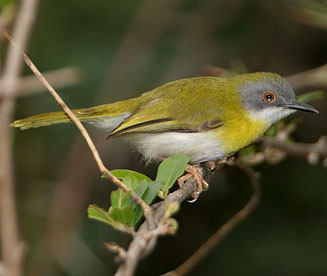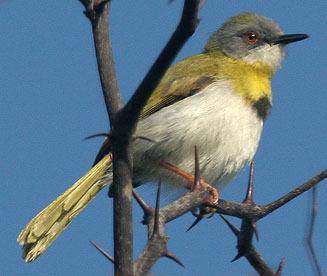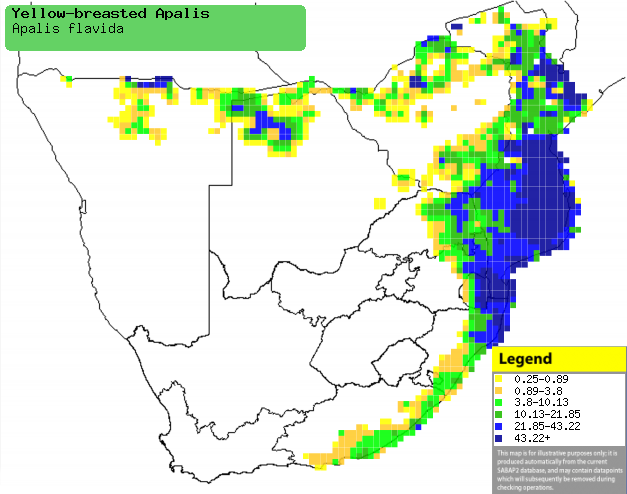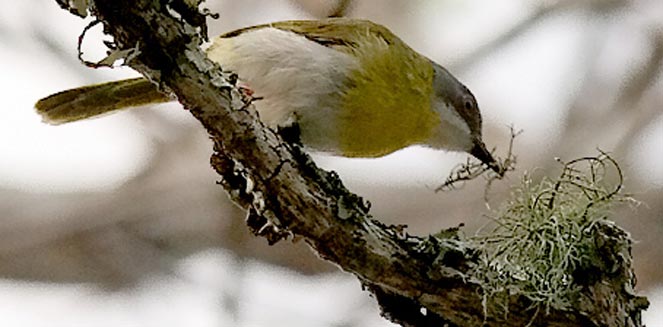|
Apalis flavida (Yellow-breasted
apalis)
Geelborskleinjantjie [Afrikaans]; N'walanga,
Xinyamukhwarani (generic terms for apalis) [Tsonga]; Geelborstapalis [Dutch];
Apalis à gorge jaune [French]; Gelbbrust-feinsänger [German];
Apalis-de-peito-amarelo [Portuguese]
Life
> Eukaryotes >
Opisthokonta
> Metazoa (animals) >
Bilateria >
Deuterostomia > Chordata >
Craniata > Vertebrata (vertebrates) > Gnathostomata (jawed
vertebrates) > Teleostomi (teleost fish) > Osteichthyes (bony fish) > Class:
Sarcopterygii (lobe-finned
fish) > Stegocephalia (terrestrial
vertebrates) > Tetrapoda
(four-legged vertebrates) > Reptiliomorpha > Amniota >
Reptilia (reptiles) >
Romeriida > Diapsida > Archosauromorpha > Archosauria >
Dinosauria
(dinosaurs) > Saurischia > Theropoda (bipedal predatory dinosaurs) >
Coelurosauria > Maniraptora > Aves
(birds) >
Order: Passeriformes > Family: Cisticolidae
> Genus: Apalis
 |
 |
|
Yellow-breasted apalis, Kruger National Park,
South Africa. [photo Trevor Hardaker ©] |
Yellow-breasted apalis. [photo
Jim Scarff
©] |
Distribution and habitat
Its distribution is patchy from Senegal to the Ethiopia
through Tanzania to southern Africa (largely absent from the DRC). Here it is
locally common in Evergreen forest, arid riverine Acacia or Mopane (Colosphermum
mopane) woodland.
|
 |
|
Distribution of Yellow-breasted apalis in southern
Africa, based on statistical smoothing of the records from first SA Bird
Atlas Project (©
Animal Demography unit, University of
Cape Town; smoothing by Birgit Erni and Francesca Little). Colours range
from dark blue (most common) through to yellow (least common).
See here for the latest distribution
from the SABAP2. |
Food
It mainly eats insects, often restlessly foraging in the
foliage of the canopy, gleaning prey from leaves and twigs. The following food items have been recorded
in its diet:
- Invertebrates
- Fruit
- Nectar of Mountain aloe (Aloe marlothii)
Breeding
- The nest is an oval ball with a side entrance, made of grass, bark,
tendrils, dead leaves, lichen, flowers and seed pods, although it is
sometimes constructed entirely of lichen. It is typically placed in a tree
or shrub, often near Usnea (old-mans-beard lichen).
 |
|
Yellow-breasted apalis constructing its nest.
[photo
Jeff Poklen
©] |
- Egg-laying season is from about October-March, peaking around
October-November.
- It lays 2-3 eggs, which are incubated by both sexes for about 12-14
days.
- The chicks are cared for by both adults, leaving the nest after about
15-17 days.
Threats
Not threatened.
References
-
Hockey PAR, Dean WRJ and Ryan PG 2005. Roberts
- Birds of southern Africa, VIIth ed. The Trustees of the John Voelcker
Bird Book Fund, Cape Town.
|
